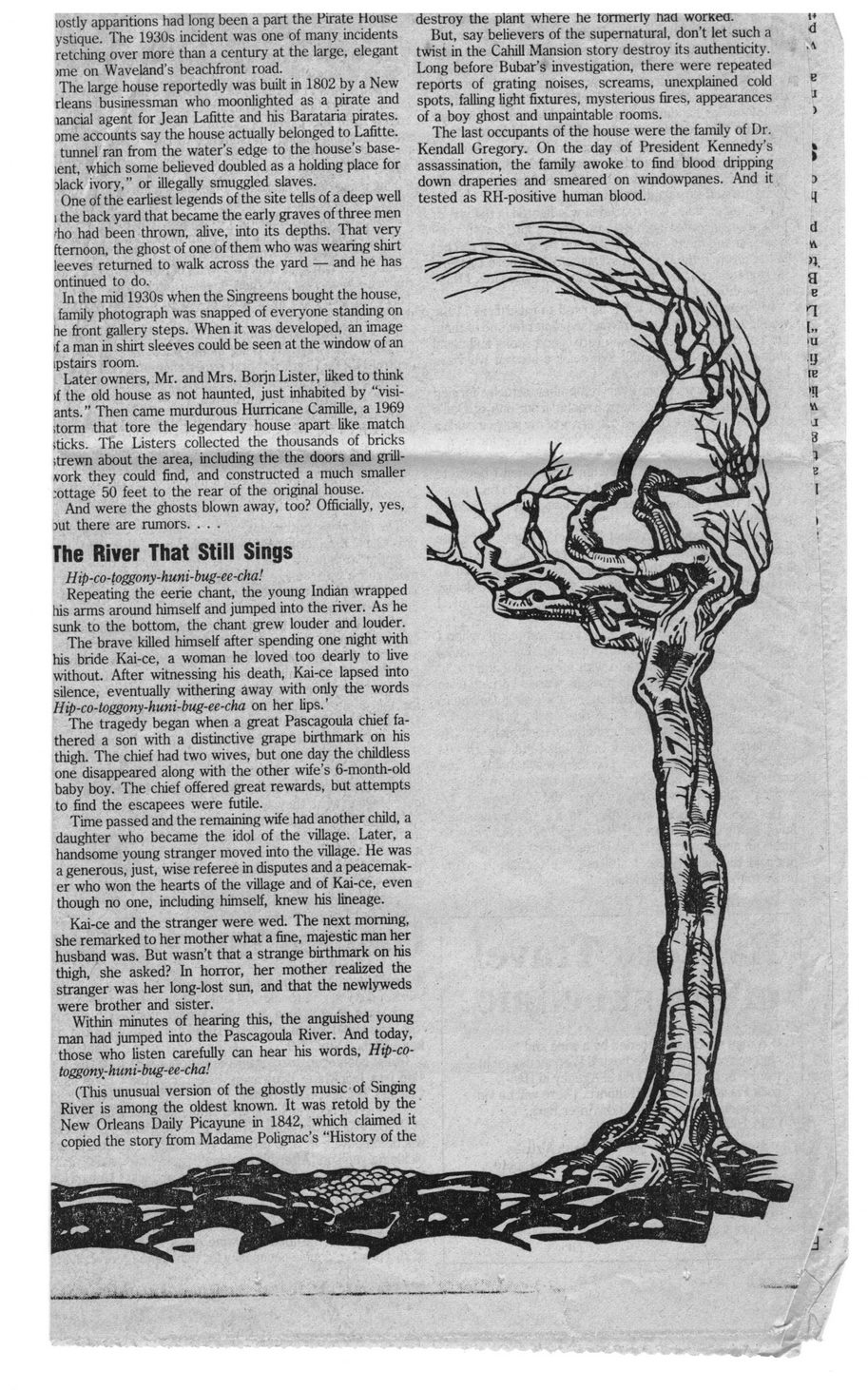This text was obtained via automated optical character recognition.
It has not been edited and may therefore contain several errors.
lostly apparitions had long been a part the Pirate House ystique. The 1930s incident was one of many incidents retching over more than a century at the large, elegant >me on Waveland’s beachfront road. The large house reportedly was built in 1802 by a New rleans businessman who moonlighted as a pirate and lancial agent for Jean Lafitte and his Barataria pirates. Dme accounts say the house actually belonged to Lafitte. tunnel ran from the water’s edge to the house’s base-lent, which some believed doubled as a holding place for Dlack ivory,” or illegally smuggled slaves. One of the earliest legends of the site tells of a deep well l the back yard that became the early graves of three men 'ho had been thrown, alive, into its depths. That very ftemoon, the ghost of one of them who was wearing shirt leeves returned to walk across the yard — and he has ontinued to do. In the mid 1930s when the Singreens bought the house, family photograph was snapped of everyone standing on he front gallery steps. When it was developed, an image if a man in shirt sleeves could be seen at the window of an ipstairs room. Later owners, Mr. and Mrs. Borjn Lister, liked to think >f the old house as not haunted, just inhabited by “visi-ants.” Then came murdurous Hurricane Camille, a 1969 itorm that tore the legendary house apart like match sticks. The Listers collected the thousands of bricks itrewn about the area, including the the doors and grill-vork they could find, and constructed a much smaller :ottage 50 feet to the rear of the original house. And were the ghosts blown away, too? Officially, yes, Dut there are rumors. . . . The River That Still Sings Hip-co-toggony-huni-bug-ee-cha! Repeating the eerie chant, the young Indian wrapped his arms around himself and jumped into the river. As he sunk to the bottom, the chant grew louder and louder. The brave killed himself after spending one night with his bride Kai-ce, a woman he loved too dearly to live without. After witnessing his death, Kai-ce lapsed into silence, eventually withering away with only the words Hip-co-toggony-huni-bug-ee-cha on her lips.’ The tragedy began when a great Pascagoula chief fathered a son with a distinctive grape birthmark on his thigh. The chief had two wives, but one day the childless one disappeared along with the other wife’s 6-month-old baby boy. The chief offered great rewards, but attempts to find the escapees were futile. Time passed and the remaining wife had another child, a daughter who became the idol of the village. Later, a handsome young stranger moved into the village. He was a generous, just, wise referee in disputes and a peacemaker who won the hearts of the village and of Kai-ce, even though no one, including himself, knew his lineage. Kai-ce and the stranger were wed. The next morning, she remarked to her mother what a fine, majestic man her husband was. But wasn’t that a strange birthmark on his thigh, she asked? In horror, her mother realized the stranger was her long-lost sun, and that the newlyweds were brother and sister. Within minutes of hearing this, the anguished young man had jumped into the Pascagoula River. And today, those who listen carefully can hear his words, Hip-co-toggony-huni-bug-ee-cha! (This unusual version of the ghostly music of Singing River is among the oldest known. It was retold by the New Orleans Daily Picayune in 1842, which claimed it copied the story from Madame Polignac’s “History of the destroy the plant where he tormeriy naa worKea. But, say believers of the supernatural, don’t let such a twist in the Cahill Mansion story destroy its authenticity. Long before Bubar’s investigation, there were repeated reports of grating noises, screams, unexplained cold spots, falling light fixtures, mysterious fires, appearances of a boy ghost and unpaintable rooms. The last occupants of the house were the family of Dr. Kendall Gregory. On the day of President Kennedy’s assassination, the family awoke to find blood dripping down draperies and smeared on windowpanes. And it tested as RH-positive human blood. i+ d e l ) k > 3 4 d A n. a e 1 l„ IU y ie •n ft J 8 1 E I

Hancock County History General Newspaper Clippings Hancock-County-Ghosts-(4)